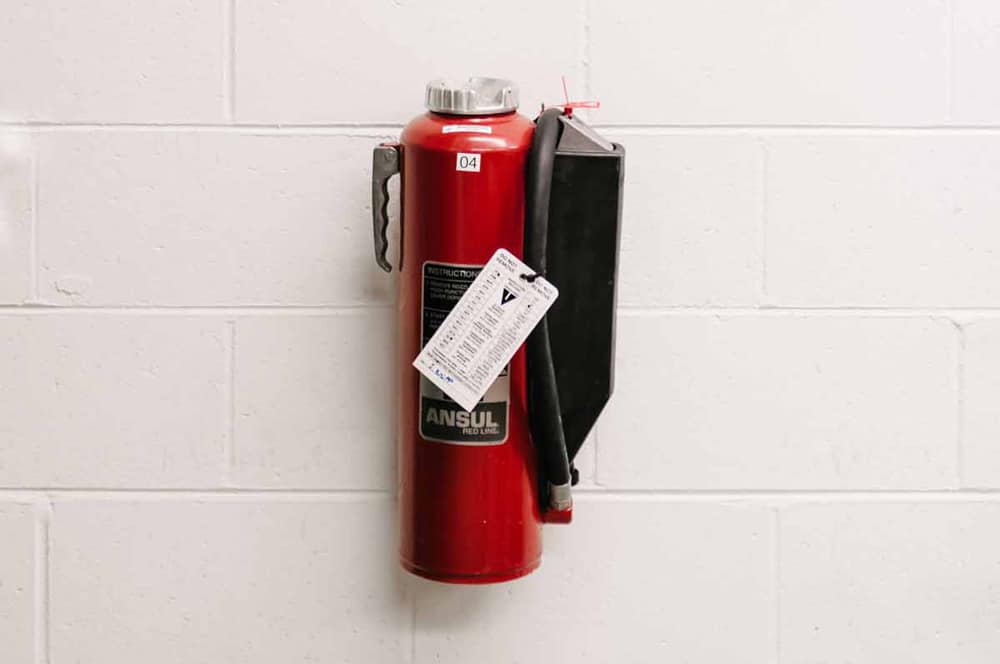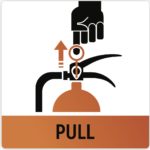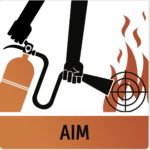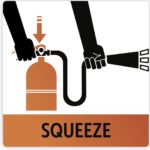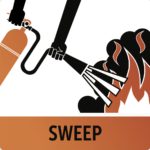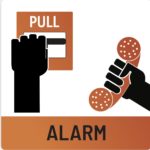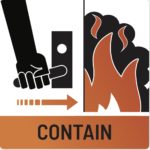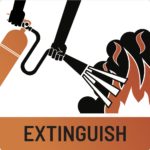Fires can be extremely dangerous if not dealt with quickly and require swift action in order to extinguish them safely. To help you deal with fires effectively, let’s start with the most important information you need to know about fire extinguishers. Then, we’ll break down the details of fire classes, fire extinguishers, and fire safety.
Fire Extinguisher 101: The Basics
Know that different types of fire extinguishers exist in order to address different types, or classes of fires. Each fire class describes the fuel or material a fire is burning or what caused it to start. Using the right extinguisher is essential to put out the fire safely. Here’s a quick chart to help you identify the right fire extinguisher for each class of fire.
| Fire Class | Fuel Type | How to Suppress | Fire Extinguisher Type |
| Class A | Freely burning combustibles | Water, Smothering | ABC/powder, water, water mist, foam |
| Class B | Burning liquid or gas | Smothering | ABC/powder, CO2, water mist, clean agent |
| Class C | Electrical fire | Non-conductive chemicals | ABC/powder, CO2, water mist, clean agent |
| Class D | Metallic fire | Dry powder agent | Powder |
| Class K | Cooking or grease fire | Smothering, wet chemical | Wet chemical, water mist |
Using a Fire Extinguisher
To use a fire extinguisher, remember the acronyms RACE and PASS.
| RACE | PASS |
|
When faced with a fire, follow these steps: Rescue all people in danger Alarm others and call 911 Contain the fire Extinguish the fire/Evacuate to safety |
To operate a fire extinguisher: Pull the pin Aim the nozzle Squeeze the trigger Sweep the nozzle from side to side |
Remember to keep your equipment up-to-date and practice fire preparedness protocols regularly, so when an emergency happens, you don’t have to think about it, you can just focus on staying calm and moving to safety.
Now that you’ve got the basics, let’s dive deeper into fire classes and fire extinguishers.
Fire Extinguisher 101: Understanding Fire Classes
The type of fire can define how quickly it burns, how dangerous it is, and the best way to suppress or put it out. Fires are categorized into classes, each with their own best approach to put them out safely and effectively. The 5 main classes of fires are categorized by what caused the fire or what the fire is using as fuel, and are as follows:
- Class A: combustible solid materials such as wood or paper, fabric, some plastics
- Class B: flammable liquids or gas such as alcohol, ether, gasoline, or grease (cooking fires are in their own class K)
- Class C: electrical fire including appliances, electronic equipment, and wiring
- Class D: flammable metallic substances such as sodium, titanium, zirconium, or magnesium
- Class K: grease or oil fires specifically from cooking – involving animal or vegetable oils or fats
Understanding the classes of fires can help you determine which fire extinguisher you need to be prepared in a fire emergency at your facility, depending on the fuels and fire hazards present.
Fire Extinguisher 101: How Fire Extinguishers Work
Fire classes help us understand how the fire starts and the best way to extinguish it, but each class may require a different type of fire extinguisher. Before we look at the different types of fire extinguishers, let’s understand how fire extinguishers work.
All classes of fires require four elements to sustain them: fuel, heat, oxygen, and a chain reaction.
Fire extinguishers work by removing one or more of these elements, suppressing the flames’ ability to spread and defeating the fire.
Different fire classes are defined by the source of the fire, and different types of fire extinguishers respond in varied ways to best defeat each class. For example, while a class A fire may be extinguished with water, the same method cannot safely be used for a class C or class K fire.
If much of this information sounds new to you, it might be a good idea to invest in fire extinguisher training. While fire extinguishers might sound fairly straightforward, studies have shown that the best way to keep your people and your property safe is to ensure everyone has the training they need, should they ever need to implement a fire extinguisher in real life.
Types of Fire Extinguishers
There are 5 types of fire extinguishers, plus combination fire extinguishers like ABC options that work to extinguish multiple types of fires. Let’s take a closer look at some of these most common types of fire extinguishers:
ABC Fire Extinguisher
This extinguisher ejects a fine chemical powder made mostly of monoammonium phosphate which blankets the fire, removing oxygen to suffocate it. Since it’s not an electrical conductor like water, a powder extinguisher can be used against liquid or gas fires, and is effective for fire classes A, B, and C.
Carbon Dioxide Fire Extinguisher
Used to extinguish CO2, this extinguisher works by removing the oxygen supply for the fire. It’s ideal for class B fires involving flammable liquids and also Class C electrical fires because it doesn’t leave any residue or require any cleanup.
Wet Chemical Fire Extinguisher
This fire extinguisher is specialized for class K or cooking fires involving fats, grease and oils. It contains a potassium solution that attacks fires in two ways: 1, the liquid mist cools the fire, and 2, a chemical reaction with the cooking medium forms a thick, soapy substance which seals the igniting surface of the liquid, preventing it from reigniting.
Water Mist Fire Extinguisher
One of the most versatile extinguishers, this type uses fine mist of microscopic, deionized water molecules to reduce oxygen in air and suffocate the fire. The mist also cools the fire, and since it’s deionized, it won’t act as a conductor, making it safe for electrical fires as well as burning liquids or gases that water alone would not work on, It can be used on classes A, B, C, and K fires
Foam Fire Extinguisher
When this type of extinguisher is used, a foam spray expands when it contacts the air, cooling and blanketing the fire as well as preventing vapors from feeding the flames. A foam extinguisher is best for liquid fires like gasoline or combustibles like wood, but it can be used on class A fires with flammable materials and flammable liquids of class B, but not gaseous fires.
Clean Agent Fire Extinguisher
This extinguisher contains a liquid which is converted into gas when sprayed. The non-conductive halon gas reduces oxygen levels and interrupts the chain reaction of the fire to suppress it. This product is safe around humans and leaves no residue, so it’s ideal for class B and C fires, and facilities with computers or electric equipment.
Fire Extinguisher 101: How to Use a Fire Extinguisher
Fire extinguishers are designed to be easy to use, but during an emergency, it can be helpful to focus on the acronym PASS to remember how to operate one effectively and safely. It stands for PULL, AIM, SQUEEZE, SWEEP.
- Pull the pin on the fire extinguisher.
- Aim the nozzle at the base of the fire.
- Squeeze the trigger to release the product.
- Sweep the nozzle from side to side.
Fire Extinguisher 101: When to Use a Fire Extinguisher
When faced with a fire emergency, you’ll need to act quickly, but prioritize safety before addressing the fire. To help you remember when to use a fire extinguisher, use the acronym RACE for RESCUE, ALARM, CONFINE, and EXTINGUISH.
- Rescue all people from immediate danger.
- Alarm by activating the closest fire alarm and by dialing 911 and reporting the location of the fire.
- Confine the area by closing doors and openings.
- Extinguish the fire it is small with a fire extinguisher (P.A.S.S.) or Evacuate the area to safety.
Fire Extinguisher 101: Best Practices
Now you know how fire classes and fire extinguishers work, you can choose the right equipment for your facility based on the most probable fire threats for your environment. Other best practices include complying with inspections, practicing a clear evacuation plan, and committing to training in fire safety and preparedness.
Comply with Regular Inspections
Remember to have equipment inspected regularly, and replace fire extinguishers once they pass their expiration. Your building should also be inspected by the local fire department to ensure that it meets fire codes regarding your space, level of capacity, and alarm requirements.
Create an Evacuation Plan
Pair your fire extinguisher selection with a straightforward and practiced evacuation plan. Make sure it is clearly posted in your building and all employees, visitors, customers, volunteers, or other people inside can easily access an evacuation route in case of emergency.
Commit to Fire Safety Training
Make sure everyone in your building, office, or facility knows how to operate a fire extinguisher and understand the best time to use it. Commit to regular fire safety training to stay current on preparedness skills, technology, and equipment.
Looking for new fire extinguishers for your building or facility? Talk to the experts at Vanguard Fire & Security. We’re here to help match you with the fire extinguishers that best match your unique needs. And, if it’s been some time since your team has had any kind of fire extinguisher training, we can help you there too!

